August 18, 2006
Air Date: August 18, 2006
FULL SHOW
SEGMENTS
Price of Nation’s Newest Weather Satellites Soar – Its Future is Cloudy
/ Bruce GellermanView the page for this story
The nation’s ability to forecast weather is in jeopardy as existing satellites get older and the replacements are over-budget and under-performing. Living on Earth’s Bruce Gellerman reports. (12:00)
The Lady and the Panda
View the page for this story
In 1936, the most sought after prize among the world’s adventurers was the rare and elusive panda bear. That the winner was a well-known New York dress designer and socialite seems nearly impossible. She was, after all, the person who once famously quipped, "the two things I hate most in life are going to bed at night and getting up in the morning." Author Vicky Croke unravels this improbable tale in her biography of Ruth Harkness called "The Lady and the Panda," and she is interviewed by host Steve Curwood. (11:00)
Fish Stories
/ Kelly JonesView the page for this story
The largest seafood market in the world, Tokyo’s Tsukiji, awakens early as fish are auctioned off to impatient buyers who inspect the soon-to-be sushi with flashlights and machetes. Reporter Kelly Jones has this audio postcard. (05:00)
Emerging Science Note/Long Life
/ Emily TorgrimsonView the page for this story
Living on Earth's Emily Torgrimson reports on developments in anti-aging treatments that have been successful in round worms. (01:30)
The Middle Ground
/ Guy HandView the page for this story
We tend to think of nature and modern agriculture as competing, often in conflict. But in West Marin County, California they're closing the divide. That's because people who live in West Marin decided decades ago that nature and agriculture can coexist and even flourish. Guy Hand reports. (15:30)
This week's EarthEar selection
listen /
download
Birds of the Russian River in California sing their songs.
Show Credits and Funders
Show Transcript
HOST: Steve Curwood
GUEST: Vicki Croke
REPORTER: Bruce Gellerman, Guy Hand, Kelly Jones
[THEME MUSIC]
CURWOOD: From NPR - this is Living on Earth.
[THEME]
CURWOOD: I’m Steve Curwood. When it comes to predicting the weather there are probably no tools more important than satellites. But our current satellite system is getting old, and the high-tech machines slated to replace them are way over budget and way overdue.
BUTLER: I've seen the government say many times, this is final, we know what we're doing, we know the root cause of the problem and we know how to fix it. And a year or two later, they're kind of back up on the Hill, their head held low, their tail tucked under, and they say, ‘well, we got another billion dollar problem, can you help us out on that?’
CURWOOD: Also, nature and agriculture as strange bedfellows in West Marin County, California.
POLLAN: If we buy into this idea of agriculture as a sacrifice zone, we're really lost. And so to the extent that this place is a reminder that it doesn't have to be that way is incredibly valuable as a cultural expression.
CURWOOD: Those stories and more - this week on Living on Earth. Stick around.
[THEME MUSIC]
ANNOUNCER: Support for Living on Earth comes from the National Science Foundation and Stonyfield Farm.
[THEME MUSIC]
Price of Nation’s Newest Weather Satellites Soar – Its Future is Cloudy

Artist’s rendition of NPOESS – the next generation of weather satellites. (Photo Courtesy of: NOAA)
CURWOOD: From the Jennifer and Ted Stanley Studios in Somerville, Massachusetts - this is an encore edition of Living on Earth. I’m Steve Curwood. The first weather satellites were launched forty years ago. Today the images they send back from space of earth’s weather are a routine part of life. Thanks to these sophisticated satellites loaded with high tech sensors, it’s now possible to predict the weather with great accuracy. But a program to build the nation’s next generation of weather satellites is years behind schedule and billions of dollars over budget. And as Living On Earth’s Bruce Gellerman reports, the crisis could jeopardize our ability to forecast the weather.
GELLERMAN: It started with re-inventing government. In 1994, Bill Clinton signed a presidential directive designed to change the way the United States purchased weather satellites. Until then NASA, the Air Force, and NOAA, the National Atmospheric and Oceanic Administration, each designed, purchased and ran its own weather satellite program. Clinton’s directive merged the three into one and, to manage it, they created a special position at NOAA. And in an unusual move, the government offered the builders of the satellites and their senior executives generous incentives to keep the project on budget and on schedule.
Amy Butler, military editor at Aviation Week and Space Technology, says the Clinton administration predicted the new way of buying satellites would save taxpayers nearly two billion dollars.
BUTLER: There was this faster, better, cheaper idea out there. The government basically said we don’t have as much money to spend but we still want to have the highest technology and the best spacecraft, so industry, come back to us and tell us what you can conjure up in your crystal ball.
GELLERMAN: They came up with NPOESS, the National Polar Orbiting Operational Environmental Satellite System.
[ANIMATION: "NPOESS…next century…"]
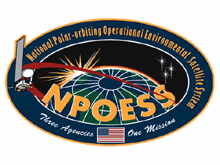
National Polar-orbiting Operational Environmental Satellite System (NPOESS)(Photo Courtesy of: NOAA)
[ANIMATION: the instruments….to our future…]
GELLERMAN: NPOESS state-of-the-art sensors would make five-day weather forecasts as accurate as our current three-day predictions. In fact, with NPOESS, meteorologists could make not just forecasts but "nowcasts." The satellite’s high-speed communication links would give scientists on the ground almost instant access to data gathered in space.
The defense department also had high hopes for NPOESS. It meant that instead of just coping with the weather, military planners could anticipate and exploit it for tactical advantage. Critical to this mission was an advanced sensor called VIIRS, an infrared device designed to peer through clouds day and night, scanning the earth and oceans. As this promotional video explains, VIIRS promised to make it possible to more accurately predict when and where hurricanes hit.
[VIIRS….Audio]
GELLERMAN: But it turns out building weather satellites and sensors is rocket science.
[VIIRS …Audio]
GELLERMAN: While Northrop Grumman is the prime contractor of NPOESS, Raytheon is the subcontractor responsible for building the billion-dollar VIIRS sensor. Raytheon engineers had experience building a similar instrument and expected few problems with VIIRS. But by 2004 it became obvious the company had vastly underestimated the task. The sensor was too heavy. Its cooling system failed. There were electronic interference problems. The staff was fired and replaced.
The government project manager began calling VIIRS ‘our problem child.’ By mid-2005, Congress took notice. That's when lawmakers were notified that delays in the VIIRS sensor were stalling the entire weather satellite program. But the real surprise came when members of the House Science Committee were briefed last fall. Republican Chairman Sherwood Boehlert says lawmakers got a heavy dose of satellite sticker shock.
BOEHLERT: There are a lot of reasons to be shocked at this stage of the proceedings. That is shocking to me in my official capacity. It is shocking to me as a taxpayer.
GELLERMAN: NPOESS was supposed to cost six and a half billion dollars, but by last summer the price tag had risen to eight billion dollars. By December it soared. The Department of Defense estimated it would cost nearly fourteen billion dollars. Congressman Boehlert says that’s more than three times the annual budget of NOAA, the agency that’s in charge of the weather satellite program.
BOEHLERT: But the fact of the matter is there were all sorts of warning signs along the way that things were getting somewhat out of control, and then finally it spun almost completely out of control.
GELLERMAN: Both Northrop Grumman and Raytheon refused repeated requests for on-the-record interviews about their satellite contracts. Northrop Grumman did initiate a series of so-called ‘Deep Dive’ investigations of the program and its subcontractors, yet, inexplicably, at the same time it was giving Raytheon an award for being on budget and on time.
Congress also investigated, and so did NOAA's Inspector General, Johnnie Frazier. Frazier focused on the money trail. He discovered that while the government's project manager, John Cunningham, was well aware of the growing problems, he continued to pay Grumman $124 million dollars in incentive awards. That's nearly all of what Grumman would have earned had it actually been on budget and on schedule. Frazier testified before Congress in May:
FRAZIER: That fee is intended to produce excellence, it’s intended to encourage performance. If I give you 84 percent of the fee when you have a horrible track record, what incentive do you have to try to do better? I think almost none.
GELLERMAN: Federal investigators also discovered that senior government officials who bore ultimate responsibility for NPOESS had met only twice in one and a half years while the program was careening out of control. One of those senior officials in charge was NOAA Administrator Admiral Conrad Lautenbacher. Lautenbacher refused to meet with the Inspector General, Johnnie Frazier, but he did testify before Congress.
LAUTENBACHER: I have agreed that we’ve learned the lessons that Johnny has talked about. This is a difficult program to manage, because it has three agencies and it has complexities involved technically, which are very, very challenging. Remember I’m the head of an agency, so I’ve got lots of people and lots of problems and lots of programs that all need help. This is a top priority and I spend a lot of time on this one, but there’s only so much that I can absorb and understand.
GELLERMAN: Neither Republicans nor Democrats were buying his explanation. Heads began to roll. The NPOESS program director was fired, Raytheon and Grumman replaced senior officials, so did the Air Force. And after hearing Lautenbacher's testimony, ranking Democrat Bart Gordon was almost speechless, but he made it clear he wanted the admiral to go, too.
GORDON: You know, you’re an admiral. You know, I mean, that is, you know, I mean, in sum, this is just embarrassing. I just simply can’t understand it. I would be embarrassed to be in your situation and not try to do more. And not to even meet, to get more information, it just gives me great concern.
GELLERMAN: Now when military contracts rise more than 25 percent over their original bids it triggers a mandatory review by the Department of Defense. If military officials found the weather satellite system wasn't necessary for national security, they could kill it. Congressman Sherwood Boehlert quoted Woody Allen to characterize the situation.
BOEHLERT: We’ve arrived at the crossroads. One road leads to hopelessness and despair, the other to total extinction. Let us pray we have the wisdom to choose wisely.
GELLERMAN: After an intense review, the Pentagon chose to keep NPOESS alive. Military officials concluded the weather satellite program was essential to national security. But it cut the program dramatically. The first launch date has been pushed back five years to 2013, and now the government plans to buy not six satellites, but just four. And the price tag? It's almost double the original estimate.
In addition, five instruments that had been planned will be eliminated, including those that were to help track climate change. However, VIIRS, the infrared sensor that was responsible for most of the cost overruns and delays, was not cut. It will be built. But reporter Amy Butler of Aviation Week and Space Technology doubts that, even with these changes, this is the end of the weather satellite's problems.
BUTLER: I've seen the government say many times, this is final, we know what we're doing, we know the root cause of the problem and we know how to fix it. And a year or two later, they're kind of back up on the Hill, their head held low, their tail tucked under, and they say, ‘well, we got another billion dollar problem, can you help us out with that?’

Artist’s rendition of NPOESS – the next generation of weather satellites. (Photo Courtesy of: NOAA)
CURWOOD: Bruce Gellerman joins me now to talk about more of this, and in particular Bruce, I want to ask you, the military can’t be very happy about having to look to the Europeans for some this information.
GELLERMAN: That’s precisely right, but you know Steve, it’s not just our weather satellites system that’s in serious trouble, but our entire constellation of orbiters: the spysats, communication, navigation, you name it. They’re mostly from the Cold War era, and the government is now in the process of replacing them all, but all of them have a problem. I recently spoke with defense consultant Loren Thompson from the Lexington Institute.
THOMPSON: One thing that they all have in common is that they’re over budget, and they’re behind schedule. When you see a pattern like that, regardless of who the contractor is, the conclusion you come to is that this must be an endemic problem with the customer, in other words, with the government.
CURWOOD: Okay Bruce, so it’s the government’s fault, maybe government’s just too tough a customer?
GELLERMAN: Well, yeah, but except for Boeing, for these satellite builders - and there are only a few of them – the government is their only customer.
CURWOOD: So you’re saying there’s no competition, and that’s the problem?
GELLERMAN: No, there is competition, it’s tremendous and intense between contractors like Northrop and Raytheon, but I spoke with Jeremy Singer – he’s a reporter with Space News – and he’s investigated this issue, and he says it’s precisely the intense competition that contributes to the problem.
SINGER: You know, one of the other problems has just been very poor cost estimating with satellites, in part driven by the budget constraints that the Pentagon has, and contractors who are effectively incentivized to underbid on the programs, and they would come in with cost estimates that they knew they couldn’t meet. Ultimately the budgets would balloon.
CURWOOD: So what you’re saying is that in other words the government expects too much from the satellites it buys, it’s willing to pay too little, so therefore the defense contractors figure this out, and to win the bids they lowball their estimates but then they come back looking for a lot more.
GELLERMAN: Precisely, and that’s why we’ve got very serious problems with virtually every satellite we’ve got in the sky.
CURWOOD: Living On Earth’s Bruce Gellerman. Thanks Bruce.
GELLERMAN: You’re very welcome.
[MUSIC: Marconi Union "Sleepless" from ‘Distance’ (All Saints Records – 2006)]
Related links:
- NPOESS – National Polar-Orbiting Operational Environmental Satellite System
- Northrop Grumman Corporation
- U.S. Government Accountability Office Report
- Inspector General's investigation
CURWOOD: Coming up: a story of love, lust and obsession in pursuit of one of the world’s most elusive creatures. The Lady and the Panda – when we return. Keep listening to Living on Earth.
[MUSIC: Roots Tonic "JD3" from ‘Meets Bill Laswell’ (ROIR – 2006)]
The Lady and the Panda
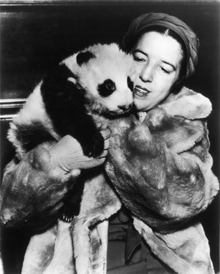
Ruth Harkness and Su-Lin in the United States. (Credit: Photo: Mary Lobisco ©)
CURWOOD: In 1936, New York socialite and dress designer Ruth Harkness, who once said she wouldn’t walk a block in Manhattan if she could take a cab, set out on an impossible journey to do an impossible task. She traveled to the most rugged and remote terrain of China to capture one of the planet’s most elusive creatures, the panda bear.
She walked up to thirty miles a day in her quest, amid the dangers of China’s raging civil war. Winning the race to be the first person to bring a live giant panda to the west, she set off a national sensation in the U.S. upon her return.
Joining me now is author and Living on Earth contributor Vicki Croke, who’s written a biography of Ruth Harkness, called "The Lady and the Panda." Vicki, good to talk with you again.
CROKE: Steve, thank you for having me on.
CURWOOD: Now, how did she get into this? Obviously, a dress designer doesn’t set out in life to go bring back the first live panda.
CROKE: She had always fantasized about visiting exotic places and she fell in love with a man named William Harvest Harkness, Jr. You can tell just from that name his background. He was an ivy league educated rich boy, an adventuring rich boy and he joined in this great race, which was very hot at the time, to try to be the first person to bring a giant panda back to the States. He went over to China, spent two years there and died very young, 34 years old, of throat cancer. And amazingly, at that moment, Ruth decided she did not want his mission to die with him and that she would take up his cause.
CURWOOD: Tell me more about Ruth Harkness. What was she like as a person, do you think?
CROKE: Very intriguing person and what we know today from the few people who are alive to tell the story of having met Ruth Harkness is that she’s the kind of person who would just light up a room. Very charismatic, very striking. Every man wanted to romance her. Every woman wanted to be her best friend. She’d already transformed herself once before. She came from a small town in western Pennsylvania, and when she moved to Manhattan she became a dress designer and a socialite sought after for every party. She was a quintessential flapper. She said that there were only two things she hated to do: go to sleep at night and get up in the morning.
CURWOOD: A lot of people were trying to get pandas in China. Some pelts have been brought back. No one had brought a live one back and all these adventurers were men. How is it that a woman is able to succeed here? And why, in fact, do you think from your studying this story do you think that being a woman perhaps gave her an edge to succeed?
CROKE: Even at the time, people began to say that she had not succeeded despite being a woman, but because of it. Many of the western adventurers, all male, would come into a country and they’d lay out the maps, they’d hire porters and they would direct themselves to wherever they thought the prize would be. Ruth Harkness took a very different tack. She came to Shanghai. She decided she did not want to work with fellow westerners. She wanted to work with a Chinese partner who was Quentin Young, 21 years old, and she listened to what he had to say. He had explored in that area before. He spoke the language and he told her he could bring her to where the pandas were.
CURWOOD: Okay, she goes to the edge of China, way up towards Tibet, to look for those pandas. How does she find one?
CROKE: It’s an interesting story. Soon after they got to the mountains, the Qionglai Sagan, they had three camps set up and within days of being in the second camp she went out with Quentin Young, the hunters and the porters. It was extremely foggy up at that elevation, which was probably about 10,000 feet. And that morning they were hiking through the wet bamboo forest, soaking wet from head to toe, couldn’t see more than a foot in front of them, and a rifle was fired and Harkness was petrified. She’d given orders that no panda was to be shot; she was afraid of what was happening around her, but she couldn’t see. It was absolute chaos and confusion and then they all heard a baby cry and Quentin Young ran over to the hollowed out rotted tree nearby and he pulled out from that hole in his hands a tiny little black and white ball of fluff which was a young panda.
CURWOOD: Now, originally the notion of going to China to bring back a live panda was, I gather, to bring back, you know, a big one. Because they’re giant pandas. So, how did bringing back a baby panda fit into that vision?
CROKE: It’s interesting. It solved a problem that a lot of people had thought about and that is that bamboo is the diet of an adult panda. Also, pandas are rather large, pretty ferocious animals. They want to be left alone. So all of the western hunters who came in brought traps and chains and cages in order to subdue these animals they assumed they would catch. Ruth Harkness in Shanghai one night thought, was thinking about the bamboo problem--how do you keep feeding a panda when you take it away from the bamboo forest? And she had an epiphany and she turned on the lamp next to her bed and she wrote down on a list, "baby bottle" and "formula." And so she had with her the most important equipment she could have brought and that is a means of feeding a baby panda. And as luck would have it, that is exactly what she got.
CURWOOD: So, how does she manage to get this animal across the world? I mean, one that’s still very difficult to keep in the zoo and nearly impossible to breed… And why do you suppose that she was thus the first able to do this?
CROKE: Today, just this week, we know that a baby panda was born in the National Zoo and everyone’s very excited about it. If that panda survives it will be only the third, young panda, infant panda, born in the U.S. to survive into adulthood and that really highlights how incredible Ruth Harkness’ accomplishment is, because she took her little baby panda from deep inside the forest between Tibet and China to Shanghai, then on a luxury liner across the ocean to San Francisco. She went from there to Chicago and on to Manhattan and then she kept the baby in Manhattan in her flat, went from cocktail party to cocktail party, rode around in taxi cabs with him.
CURWOOD: With this baby panda in her arms?
CROKE: Yes, it was a well-socialized baby panda. He went to the best parties and teas that New York could offer.
CURWOOD: Oh, my.
CROKE: And what we believe today is that she was just intuitive. She kept that baby on her body basically the entire time. She never let him go. She said she was going to learn how to raise a baby panda from him. And he told her when he was hungry and she fed him when he was hungry. And then, even later once he had been placed in the Brookfield Zoo, I came across a letter that Ruth wrote to the zoo and she said to them, "I’m no biologist, but I think this baby should not be fed," and he was being fed at the time boiled vegetables exclusively, she said, "I think he needs bamboo and also other, what she said, "flinty substances." He needs to chew on something and it’s remarkable in this day and age to think that just her simple logic and intuition made more sense than these zoologists who consider themselves experts in animal care.
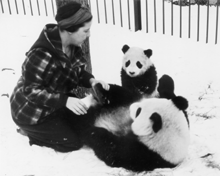
Ruth Harkness helps introduce Su-Lin to Mei-Meil at Chicago’s Brookfield Zoo.
(Photo: Mary Lobisco ©)
CROKE: She made the front page of just about every newspaper in the country from coast to coast for weeks. She was in every newsreel on every radio station and Time magazine proclaimed her capture a scientific prize of first magnitude.
CURWOOD: Vicki, there’s this memorable scene, one that almost seems like a second turning point in the life of Ruth Harkness that she takes a panda that she’s captured in the wild back to the wild where she found her and let her go. Could you tell me that story, please?
CROKE: On her third expedition in 1938, she had in hand a very young panda that she named Su-lin and her, Ruth’s entire future would depend on her returning to the United States with a panda. She’s in Chang Dao and she realizes that the valleys where she had been before are now empty of pandas. There’s been a gold rush of other panda hunters and they are hunting and trapping as many pandas as possible. Many of them, dozens are dying along the way, either in the process of hunting them or bringing them back to Chang Dao and keeping them in cages. And she becomes heartsick. Her original vision was that she would bring back mated pairs of pandas to the United States and we would be sure that we have a population here. And what she’s seeing instead is that too many pandas are dying, that they’re not mating in the United States and so she is sitting in a Chinese pavilion in the city of Chang Dao with little Su-sen and she makes an incredible decision and that is to put her expedition in reverse as she says, and she brought Su-lin back up into the mountains where she had been caught and she sets her free.
CURWOOD: Vicki, tell me, to what extent do you think that the work of Ruth Harkness ended up being beneficial to pandas? Which I think you’d say in the end, was what she cared the most about.
CROKE: It’s interesting to me that the World Wildlife Fund, Desmond Morris, and other historians have credited Ruth Harkness with making a tipping point in the history of animal capture and that is she was doing her work in a time when men went into the forest and blasted away. She brought back this little baby panda that the world fell in love with and she made the world panda-conscious. As one historian said, she did more for the giant panda that day when she hit the docks of San Francisco with Su-lin than most wildlife biologists can do in a whole lifetime. So I think what Ruth did was pretty remarkable. And to the American public it was an important point in time where they fell in love with an individual animal. An animal that seemed to them to have a personality and a right of its own to live. And so never again would it be considered romantic to go off and kill animals in the forest and bring back their pelts.
CURWOOD: Vicki Croke’s book is called "The Lady and the Panda: the True Adventures of the First American Explorer to Bring Back China’s Most Exotic Animal." Thank you Vicki, for taking this time.
CROKE: A sheer pleasure, Steve. Thank you.
[MUSIC: Billie Holiday "Got To Love Me" from ‘Ken Burns Jazz Collection’ (Polygram Records - 2000)
Related link:
"The Lady and the Panda" by Vicki Croke
Fish Stories

Fresh tuna auction. (Photo: Kelly Jones)
CURWOOD: Tourists are no longer welcome at the fresh and frozen tuna auctions at the Tokyo central wholesale market known as Tsukiji. It seems all those camera-toting curiosity seekers were getting in the way of business. Fortunately for us, Kelly Jones and her microphone did get the chance to record and send us this audio postcard.
JONES: More than six and a half million pounds of seafood from the world’s seven oceans arrive here at Tsukiji nightly. One kind in particular, bluefin tuna, darling of sashimi platters and, some say, endangered because of it. I trade in my shoes for a pair of cream colored galoshes and make it just in time for the opening bell of the fresh tuna auction.
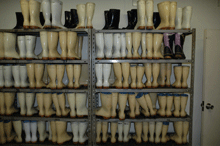
(Photo: Kelly Jones)
JONES: Picture an airplane hangar filled row upon row with fat titanium- and black-skinned fish so huge a hefty 10-year old could crawl inside. There are 350, maybe 400 of the submarine-shaped bluefin lying on individual wooden platforms on the cement floor. In just over an hour, all of them will sell.
[AUCTIONEER CHANTING]
JONES: An auctioneer on a footstool bobs and sways like a minister in a Pentecostal church. He moves ecstatically, all hand gestures and nods, his shoulders scrunching in time with his singsong chant.
JONES: All around him, potential buyers don poker faces and wield long-handled hooks. They crouch with flashlights, peer into sliced open bellies and prod cleaned-out cavities for the magic combination of scarlet flesh and abundant fat.
CUSTOMER: How much are these tuna selling for?
MERCHANT Expensive tuna cost 30,000 per kilo. And the average is 2,500.
JONES: That’s 30,000 yen, or about 280 dollars a kilo for a typical whole fish so giant it takes two grown men with hooks a few swings and then one mighty heave to hoist the creature onto a flatbed wheelbarrow.
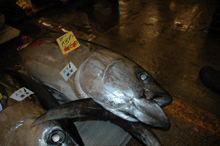
Fresh tuna. (Photo: Kelly Jones)
JONES: Just a few steps away, men toss empty styrofoam boxes into a story-high heap and guys on tiny diesel trucks zigzag around them as another auction gets underway, this one for frozen tuna.
[STYROFOAM SQUEAKING]
JONES: These fish look ghostly all covered in frost, and when the day’s heat collides with their cold, a billow of fog wafts up from the floor. One picky fellow thwacks away at a fish, its frozen meat flaking off the blunt end where its tail used to be. These are the mebachi tuna. English name: big eye. And there are a lot of big eyes staring out at me, as I turn to find the market for live fish.
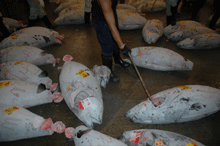
Dragging frozen tuna. (Photo: Kelly Jones)
JONES: A few flights up at street level, I see a maze of wooden tables holding square blue plastic baskets that bubble with sea water, keeping the just caught contents alive. In one basket, a half-dozen silver mackerel are floating listless on their sides. I turn around just in time to see a lithe young man wearing a bloody apron pull a wide, flat flounder from a bucket, smack it down on a cutting board and slit it clean down the belly. As he reaches for the next one, I head for the exit, which takes me right past a bucket of still-twitching fish heads gasping their last.
[CARS GOING BY ON THE STREET]
JONES: Out on the street, I happen by chance at NamiYoke, the guardian shrine for Tsukiji. It’s a place where buyers and sellers give thanks for the fish and the livelihood they bring. Tombstones for the fish line the wall, as if saying, rest in peace, little fellas. Sorry we had to cut your heads off. Just seeing this makes me feel better. So does the sight of a man carrying two empty wicker baskets bowing deeply at the shrine before hurrying off to the market. I’m Kelly Jones.
[MUSIC: Anonymous Japanese Flute Music]
CURWOOD: You can hear our program anytime on our website, or get a download for your ipod, or other personal listening device. The address is LOE dot org. That's LOE dot O-R-G. You can reach us at comments @ LOE dot org. Once again, comments @ LOE dot O-R-G. Our postal address is 20 Holland Street, Somerville, Massachusetts, 02144. And you can call our listener line, at 800-218-9988. That's 800-218-99-88. Cd's and transcripts are fifteen dollars.
CURWOOD: Just ahead: marrying nature and modern farming in West Marin County, California. First, this Note on Emerging Science from Emily Torgrimson.
Emerging Science Note/Long Life
TORGRIMSON: Like a firmer body, smoother skin, and a more youthful appearance? Want a fountain of youth and the promise of immortality and vitality? Well, honey, don't we all. Worms included.
Scientists at the University of California in San Francisco have doubled the life span of worms by altering a single gene. They've stretched the life span of a simple roundworm from two weeks to a month. And these mature worms aren't just fading away in their relatively old age. Smooth and plump altered worms look better than worms half their age, like a 42-year-old with the vigor and potency of a supple 21-year-old.
It's by altering the gene known as daf-2 that researchers were able to approach worm immortality. Daf-2 has two parallels in mammals that are currently being tested with mice, the insulin receptor and insulin-like growth factor. By neutralizing the insulin receptor, a cell structure that regulates blood sugar, mice can live up to 18 percent longer than usual. And by reducing the insulin-like growth factor, called IDF-1, rodents can live up to a third longer.
Youth – the elusive obsession of Ponce de Leon and middle-aged consumers – is not a new field of research. Scientists have known for 70 years about a negative relationship between reduced caloric intake and a lengthened life span of animals like mice. Scientists don't know if humans, or larger mammals like monkeys, react the same way to a cutback in calories. But they'll keep exploring ways to prolong the life span of worms, mice, and humans to inconceivable lengths, and still keep us looking fabulous!
That's this week's Note on Emerging Science. I'm Emily Torgrimson.
CURWOOD: And you’re listening to Living On Earth.
ANNOUNCER: Support for NPR comes from NPR stations and: The Charles Stewart Mott Foundation, online at M-O-T-T dot org; supporting efforts to promote a just, equitable and sustainable society; The Kresge Foundation, investing in nonprofits to help them catalyze growth, connect to stakeholders, and challenge greater support. On the web at Kresge dot org; and , the Kellogg Foundation, helping people help themselves by investing in children, their families, and their communities. On the web at W-K-K-F dot org; This is NPR, National Public Radio.
[MUSIC: Roots Tonic "Akademikus Du Umbeigu" from ‘Meets Bill Laswell’ (ROIR – 2006)]
The Middle Ground
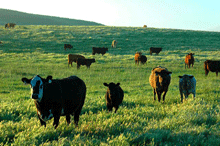
Cows in Pt. Reyes National Seashore. (Photo: Guy Hand Productions ©)
CURWOOD: It’s Living on Earth. I’m Steve Curwood. We tend to think of nature and modern farming as competing, often in conflict. But in West Marin County, California, they're closing the divide. It's a place you can drive by a dairy, past old pick-up trucks and barns, and around the next bend spot Tule elk grazing on open grasslands. The farms and the elk are both protected by law. That's because people who live in West Marin decided decades ago that nature and agriculture can co-exist and even flourish. Producer Guy Hand finds out that this mingling of the wild and domestic isn't easy, but the results are often delicious.
[CROWD NOISES, BUSES]
HAND: From this Vista Point on the north side of the Golden Gate Bridge, you could easily assume that Marin County is awash in tourists, tour buses, and tony suburban sprawl.
[BUS PULLS UP]
HAND: You'd hardly guess that just to the west, over the freeway and those house-encrusted hills, there's another, very different Marin County.
[CROWD NOISE CHANGES TO BIRDSONG]
HAND: West Marin is as distinct from the frenetic eastern third of the county as our notion of nature is from culture. Here, you'll find oak-studded grasslands, redwood and Bishop Pine forests, streams carrying coho salmon, and beaches crowded with nothing more than fog.
[STREET SOUNDS]
HAND: And small towns, like Pt. Reyes Station, where the status symbol of choice is not the car or the hot tub, but the cow. People here put their faith in small-scale agriculture for food, and also as a way to keep development at bay and nature nearby. That's why you'll find cows not only on the hills, but on t-shirts, coffee cups, baseball caps, and storefront signs for the Bovine Bakery and the Cowgirl Creamery.
[SOUNDS IN CREAMERY]
CONLEY: Milk just has so many components to it, and it's so complex, and every day it's a little bit different.
HAND: Sue Conley, a founder of the Cowgirl Creamery, makes cheese from the milk of local dairy cows, but also tries to illustrate this faith in mingling nature and culture to the three million annual tourists who come to West Marin and its national park, Pt. Reyes National Seashore.
CONLEY: So we thought it would be good to make the creamery behind glass so that visitors could start to understand the association between the land that they're seeing and the cows on the hill, and then what can be produced from these really high quality fields.
[SCRUBBING SOUNDS IN WATER]
HAND: Today, you can see a couple of workers scrubbing round softball sized cheeses in a brine.
CONLEY: This is the Red Hawk, which is our big, stinky triple cream. The red rind comes from a wild bee-linen bacteria that grows here in Pt. Reyes.
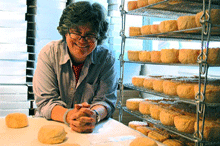
Sue Conley, founder of the Cowgirl Creamery surrounded by her award winning cheese.(Photo: Guy Hand Productions ©)
CONLEY: We grow the white mold on the outside and then we wash it off with a salty brine, and the brine encourages this wild bee-linen bacteria.
HAND [TO CONLEY]: It's delicious.
CONLEY: It's delicious, I'm telling ya (laughing).
HAND: It took decades of hard work and determination to keep West Marin pastoral, by using zoning laws, creating America's first agricultural land trust, setting aside sensitive land, and establishing Pt. Reyes National Seashore. This faith in the pastoral seems to be paying off. While farmers and ranchers and food producers struggle nationally, here there's a booming local food industry that includes small dairy and beef ranchers, cheese makers, olive growers, and oyster farmers.
[SOUND OF WATER, MUD]
ALDEN: When you're walking out on the mud you kinda wanna keep your knees bent and you want to slide your toe forward and keep your heel high.
HAND: Drew Alden, owner of the Tomales Bay Oyster Company, is giving me instructions on how to walk out to his oyster beds, fifty yards into Tomales Bay, without falling down.

Drew Alden of the Tomales Bay Oysters Company on Tomales Bay.
(Photo: Guy Hand Productions ©)
HAND: It's low tide on a beautiful sunny morning, and with a little practice I'm able to slosh my way out to the string of mesh bags sitting on the mud flats. They're filled with oysters. Alden opens a bag and pulls one out.
[SOUND OF GRABBING OYSTER SHELLS]
ALDEN: So there you are. You want an oyster? Sorry I don't have any condiments for you.
HAND [TO ALDEN]: That’s okay.
[SLURP]
HAND: Wow, really good. It has a great flavor.
ALDEN: The interesting thing about West Marin and the way agriculture is conducted here is that it’s, for the most part, not monoculture. You go to the Midwest and you see corn, and it's corn for miles, or hundreds of miles. And it’s all monoculture which means that you have to take out all of the other species that live there and then plant your seed. Whereas, particularly in an oyster farm, we live in concert with all the other organisms that live in this farm.
HAND: Alden says an oyster farm actually enhances biodiversity. There's no fertilizer or feed to potentially contaminate the bay; the oysters just live off the nutrients naturally found in the water. And the oyster bags attract other native oysters, barnacles, and mussels, which then attract still more creatures.
ALDEN: Fish come in as the tide comes up because you've got all these forage species attached to our farm. And then birds come in and chase the fish. So there's this whole biodiversity that takes place as a result of this farm being here.
HAND: As Alden talks, I find myself sinking a little too deep in biodiversity.
HAND [TO ALDEN]: How do I get unstuck? I think I'm pretty well grounded here. (laughing)
ALDEN: Okay, bend your knee. Lift your heel.
HAND: Oh, okay.
ALDEN: And pull your toe out.
[REGGAE MUSIC AND CONVERSATION]
FINGER: How you folks doing?
HAND: A few miles up Highway 1, John Finger, another oyster farmer, is talking to some customers.
FINGER: Okay, so why don’t you go get yourself set up in the picnic area and then come back and we'll get you set up with oysters and you’ll be on your way.
HAND: Finger's Hog Island Oyster Company produces about three million oysters a year. Business is booming. But this is where this story of pastoral bliss gets complicated. Oysters require pristine water and Tomales Bay is one of only four spots in California clean enough to grow oysters commercially. But the bay is not always clean enough.
FINGER: In 1998, we had 170 people get sick from eating oysters from this bay. From our company and a couple others.
HAND: On May 14, 1998 all six of the commercial shellfish growers in Tomales Bay were closed down for several weeks due to an unknown pathogen. Subsequent studies showed the culprit to be a virus, possibly from faulty septic tanks. But further testing showed that agriculture was adding significantly to pollution in the bay. John Finger:
FINGER: We've done enough studies to know that there are certain streams and certain watersheds that contribute most of the fecal coliform loading into this bay. And the characteristics of those watersheds are that they have ag operations and primarily dairies on them.
HAND: A century ago, dairies were purposely built along the creeks on the hills above Tomales Bay. Those waterways flushed waste and manure downward, away from farms. But nowadays, those same dairies have to fight gravity to keep from tainting the bay. The problem gets worse during California's infamous winter rainy season.
FINGER: During rainy weather the runoff has fecal coliform in it, and the fecal coliform count in the bay goes up and we get closed to harvesting. So if it rains, say, over a half inch in 24 hours, we get closed anywhere from four to six days. And if another storm comes in before you get open it just tacks another four to six days on, so you can get some running closures of ten, fifteen days.
HAND: Currently, oyster growers on Tomales Bay have to close down their operations about 70 days a year.
[TRUCK ENGINE STARTING]
HAND: Gordon Bennett, a member of Sierra Club's Agricultural Advisory Committee, is taking me on a tour of the pasture lands above the bay. He quickly finds a place with problems.
BENNETT: First of all you see a bunch of cows over there, and right behind them you see what looks like a crack in the ground. And at one time that had trees on it. And the trees have all been trampled and destroyed by the cows. And the cows now can access that creek and all that cow manure and sediment is flowing down the creek, connecting to the tributary and flowing right into Tomales Bay. There's that all over the watershed.
HAND: Even still, Bennett wants agriculture to stay on this land. It's the only way, he believes, to keep the far worse threat of trophy homes and golf courses from taking over West Marin. But his attempt to find a middle ground has not always been popular with his peers.
BENNETT: Very often, people in the environmental movement, like people in any other movements, they tend to often times get very simplistic, and they have a solution that says, well, it either has to be all wilderness, or it's all urban. To go at a project that is much more subtle than that, that doesn't deal with absolutes but deals with balances, is often times much more difficult for people in the environmental movement to understand, appreciate and support.
HAND: That subtle landscape that blends nature and farming, isn't something that corporate agriculture always appreciates and supports either. The belief in a sharp divide between nature and culture is, after all, the rational behind factory farms. Proponents of industrial farming say it can free up land like West Marin for other, more environmentally friendly uses.
EVANS: I think there's a very basic assumption in that statement – that's that agriculture is bad and is detrimental to the environment, and I don't believe that.
HAND: David Evans is a fourth generation Marin County rancher who says the divide between agriculture and nature is a false one.
EVANS: I believe that if you fit the agriculture to the landscape that it is not detrimental to the ecosystem and the environment, and the two can live hand in hand.
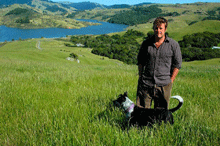
Fourth generation Marin County cattle rancher David Evans standing in a pasture that he believes is environmentally healthy because of cattle grazing.(Photo: Guy Hand Productions ©)
EVANS: So, that begs the question, then, why do we have cattle here? Why not bring in the large herds of elk? And, essentially, this is where the compromise comes in. Large herds of elk in this area, to sustain the grasslands the way they once did, would need to exist in very large numbers and be able to roam very large areas. That can't happen now. We have roads, highways, fences, so forth. Therefore, agriculture has been able to step in, keep the relationship that is existing between grass and ruminant animal for eons and maintain the landscape and the stability of that landscape.
HAND: When it became clear that Tomales Bay was threatened by pollution, the environmental and agricultural community did a remarkable thing: they came together. They created the Tomales Bay Watershed Council and other groups that then began looking for ways to solve the problem. Sharon Doughty is a dairy farmer looking for solutions.
[WALKING SOUNDS]
DOUGHTY: See these fencings right here? One time the cows during the winter time just moved through all these areas and, I mean, they're big. And when they're walking through an area that’s wet, they will definitely chew it up. And so, we fenced this off so that the cows couldn't go through here and it did two things: it not only made it so that they couldn’t plow it up but also we let that grass grow to about a foot, foot and a half, and it acts as a filter strip for any nutrients that might be here. And I think they've found it significantly improves the water quality coming off this hillside.
[WALKING]
HAND: David Lewis, watershed management advisor with the University of California Cooperative Extension, has been helping Doughty and other farmers and ranchers stop agricultural runoff into Tomales Bay.
LEWIS: What you don't realize in looking at it today is three years ago you'd come out here and this would be bald soil, just bare soil just exposed to the rain storms through the whole winter. A lot of nutrients, a lot of bacteria, a lot of sediment was coming off of this lot.
HAND: Lewis says the simple buffer Doughty has created filters the runoff from up to 150 cows. He works in three counties and says that people in West Marin are unique in their willingness to make things right. Lewis thinks it has something to do with their shared sense of place.

David Lewis, Watershed Management Advisor with the University of California Cooperative Extension, helps ranchers keep agricultural runoff out of Tomales Bay. (Photo: Guy Hand Productions ©)
HAND: As people in West Marin work hard to find a middle ground where agriculture and nature can coexist, nature itself seems to be working on its own middle ground. The rare red-legged frog is finding a home in man-made farm ponds. Certain native grasses seem to grow better in the presence of cattle.
POLLAN: At this point, to separate out Pt. Reyes as a natural landscape and as a cultural landscape, it's almost impossible. They're completely knitted together at this point.
HAND: Writer Michael Pollan has done a lot of thinking about the interface between nature and culture. Pollan, who is in West Marin on a writing retreat, has written several books on the subject, including "The Botany of Desire."
POLLAN: And that's what happens after a period of time in any natural landscape that we have had an influence on. Something new comes into the world, and that is the kind of middle landscape that humans create.
HAND: Pollan thinks that having working farms in beautiful places like West Marin and Pt. Reyes National Seashore might be a good thing. Instead of separating nature and agriculture and thereby hiding the consequences of our food choices from view, here they're on display for everyone to see.
POLLAN: Millions of people come here every year, and reminding us as a culture that there is a way to get our milk and our meat from a place that we regard as so beautiful we'll spend our vacation in it. That's a really important lesson for everybody. If we buy into this idea of agriculture as a sacrifice zone, we're really lost. And so to the extent that this place is a reminder that it doesn't have to be that way is incredibly valuable as a cultural expression.
[RESTAURANT SOUNDS]
HAND: Here, in a West Marin restaurant, I'm reminded, too, that there's never a perfect balance between landscape and food. My friends and I spend as much time debating that balance as enjoying our meal. We mull over how much pollution should be allowed into the bay, when grazing is over-grazing, where organic farming fits in. We feel none of the clarity that comes with words like "pristine," "untrammeled," and "wild." In this middle ground between nature and culture, there are no clear victories or sharp boundaries. But then again, something must be right when a place this beautiful can taste this good.
[MAN IN RESTAURANT SINGS A LINE: "Just remember it’s the farmer that feeds us all." It’s a great song about…..]
HAND: For Living on Earth, I'm Guy Hand in West Marin, California.
[MUSIC: Jesse Colin Young "Ridgetop" from ‘Song For Juli’ (Warner Bros. - 1973)]
CURWOOD: We leave you this week just north of Marin County, along the banks of the Russian River. Now there are many songbirds that call the Russian River home, and one day, Ed Herrmann recorded as many as he could. Here's a sampling:
[EARTH EAR: "Russian River Birds" recorded by Ed Hermann from ‘RUSSIAN RIVER BIRDS: North American Free Improvisers’ (Garuda Records - 1998)]
CURWOOD: Living on Earth is produced by the World Media Foundation. Our crew includes Ashley Ahearn, Chris Ballman, Eileen Bolinsky, Ingrid Lobet and Jeff Young - with help from Bobby Bascomb, Kelley Cronin, and James Curwood. Our interns are Tobin Hack and Allison Smith. Our technical director is Dennis Foley. Alison Lirish Dean composed our themes. You can find us anytime at loe dot org. I’m Steve Curwood. Thanks for listening.
ANNOUNCER: Funding for Living on Earth comes from the National Science Foundation, supporting coverage of emerging science; And Stonyfield Farm Organic yogurt, smoothies and milk. Ten percent of profits are donated to efforts that help protect and restore the earth. Details at Stonyfield dot com.
Support also comes from NPR member stations, the Ford Foundation, the Oak Foundation, and the Saunders Hotel Group of Boston's Lennox and Copley Square Hotels. Serving you and the environment while helping preserve the past and protect the future, 800-225-7676.
ANNOUNCER 2: This is NPR. National Public Radio.
Living on Earth wants to hear from you!
Living on Earth
62 Calef Highway, Suite 212
Lee, NH 03861
Telephone: 617-287-4121
E-mail: comments@loe.org
Newsletter [Click here]
Donate to Living on Earth!
Living on Earth is an independent media program and relies entirely on contributions from listeners and institutions supporting public service. Please donate now to preserve an independent environmental voice.
NewsletterLiving on Earth offers a weekly delivery of the show's rundown to your mailbox. Sign up for our newsletter today!
 Sailors For The Sea: Be the change you want to sea.
Sailors For The Sea: Be the change you want to sea.
 The Grantham Foundation for the Protection of the Environment: Committed to protecting and improving the health of the global environment.
The Grantham Foundation for the Protection of the Environment: Committed to protecting and improving the health of the global environment.
 Contribute to Living on Earth and receive, as our gift to you, an archival print of one of Mark Seth Lender's extraordinary wildlife photographs. Follow the link to see Mark's current collection of photographs.
Contribute to Living on Earth and receive, as our gift to you, an archival print of one of Mark Seth Lender's extraordinary wildlife photographs. Follow the link to see Mark's current collection of photographs.
 Buy a signed copy of Mark Seth Lender's book Smeagull the Seagull & support Living on Earth
Buy a signed copy of Mark Seth Lender's book Smeagull the Seagull & support Living on Earth

